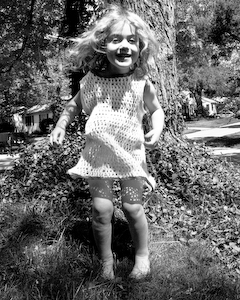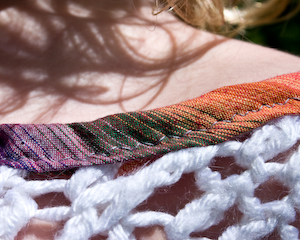I am cheap. Cheap, cheap, cheap. Oh, and also eco-friendly, but mainly just cheap. My favorite thing about the DIY lifestyle is that it’s also a thrifty lifestyle. It’s inspiring to take an unwanted, perhaps even damaged material something that someone else might discard or donate, and turn it into something that’s beautiful and useful again. Take those sweet, knitted or crocheted afghans that I’m always coming across in thrift stores or dumpster-diving, or that often get re-gifted to me because I like handmade stuff. I respect the love and time that goes into the act of knitting and crocheting, and the dedication, especially, that it takes to create an entire afghan, but frankly, I have enough of my own already, and I don’t necessarily need another one, especially if it’s just so-so or (gasp!) ugly. An entire afghan, though? That’s a nice, large swatch of material to work with. I’ve been sewing up a storm with my thrifted and re-gifted afghan stash, lately, making some simple summer dresses for my little girls. Here are some tips so that you, too, can sew with knitted or crocheted materials–it’s not as tricky as it seems:
Tip #1: Use the sturdiest stitch in your arsenal. When sewing two pieces of knitted or crocheted material together, overlap them by half an inch and sew them together with a narrow zigzag stitch, or even an ex stitch–you’re not going to catch both pieces of fabric with every single stitch, especially if your fabric is very open weave, so the more thread you throw at your stitch, the more fabric you’ll catch. Tip #2: Match your thread perfectly. Your stitches won’t look as neat as they would if you were sewing together two pieces of quilting cotton, but this won’t be noticeable if you match your thread perfectly. Tip #3: Cut, then sew. Don’t give your fabric time to unravel by cutting out a piece, then sticking it on top of your pile of unfinished pieces for five months. Give yourself time to cut and sew your project today. Tip #4: Cover your seams. Bias tape makes a neat finish for any raw edge (see this tutorial for how to hem with bias tape), but you can also use single-fold bias tape to cover any seam. For instance, I use double-fold bias tape to hem the neckline, armpits, and bottom hem of the dresses I make my girls out of afghans, but I use single-fold bias tape to cover the side seams and shoulder seams where I’ve sewn afghan fabric to afghan fabric. Doing so keeps any raw bits from unraveling, gives a neater look to the seam, and keeps the open-weave material from stretching too much when it’s worn. Tip #5: Knitted and crocheted fabric is stretchy, but forgiving. Sew it to take advantage of its benefits. It drapes well, is easy to pull on and take off, and is stretchy and comfortable. It won’t hold an intricate or complicated shape well, it can be heavy, and you can see through it. Remember that before you make yourself a cute little top or a pair of pants or whatever. Remember, too, that my girls and I aren’t sensitive to certain fabrics. We can happily use and wear afghans of indeterminate origin, because we’re fine with cottons, synthetics, and wools. If you’re not so lucky, you’ll have to be more careful, obviously. What do you do with your extra afghans?

